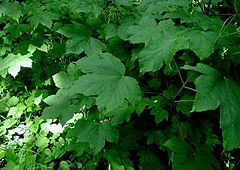Sycamore Maple
| Acer pseudoplatanus subsp. var. | Sycamore Maple | |||||||||||||||||||||||||||||||||||||||||||||||||||||||
|---|---|---|---|---|---|---|---|---|---|---|---|---|---|---|---|---|---|---|---|---|---|---|---|---|---|---|---|---|---|---|---|---|---|---|---|---|---|---|---|---|---|---|---|---|---|---|---|---|---|---|---|---|---|---|---|---|

|
|
| ||||||||||||||||||||||||||||||||||||||||||||||||||||||
| ||||||||||||||||||||||||||||||||||||||||||||||||||||||||
Acer pseudoplatanus, Sycamore (or Sycamore Maple, to distinguish it from other plants called sycamore) is a species of maple native to central Europe and southwestern Asia, from France east to Ukraine, and south in mountains to northern Spain, northern Turkey, and the Caucasus.[1][2] In Scotland, the Sycamore is known as the Plane tree, although it is not a member of the Platanus genus.
It is a large deciduous tree that reaches 20–35 m tall at maturity, with a broad, domed crown. On young trees, the bark is smooth and grey but becomes rougher with age and breaks up in scales, exposing the pale-brown-to-pinkish inner bark. The leaves are opposite, 10–25 cm long and broad with a 5–15 cm petiole, palmately veined with five lobes with toothed edges, and dark green in colour; some cultivars have purple-tinged or yellowish leaves. The leaves are often marked with black spots or patches which are caused by the fungus Rhytisma acerinum[3]. The monoecious yellow-green flowers are produced in spring on 10–20 cm pendulous racemes, with 20-50 flowers on each stalk. The 5–10 mm diameter seeds are paired in samaras, each seed with a 20–40 mm long wing to catch the wind and rotate when they fall; this helps them to spread further from the parent tree. The seeds are mature in autumn about 6 months after pollination.[2][4]
The flowers produce abundant nectar, which makes a fragrant, delicately flavoured and pale-coloured honey.
| Standard Cyclopedia of Horticulture |
|---|
|
Acer pseudoplatanus, Linn. Sycamore Maple. Tree, 70 ft. high: lvs. 5-lobed. coarsely crenate-serrate, 3 1/2-7 in. across, deep green above, glaucous and mostly glabrous beneath: racemes pendulous: fr. glabrous. Eu., Caucasus. —Large tree of vigorous growth, with large, spreading head; thrives well even in exposed situations. Many varieties and garden forms: Var. villosum, Presl. Lvs. chartaceous, pubescent beneath. Var. erythrocarpum, Carr. Fr. right red: lvs. smaller and more lustrous. Var. purpurascens, Pax (vars. purpureum and atropurpureum, Hort.). Lvs. purplish red beneath; of robust growth. Var. Handjeryi, Spaeth (var. Prinz, Handjery, Hort.). Lvs. purplish beneath, bright red when unfolding. Var. Worleei, Schwerin (var. lutescens, Hort.). Lvs. yellow. Var. albo-variegatum, Kirchn. Lvs. with white blotches and spots, reddish while young. Var. Leopoldii, Lem. Similar to the preceding variety; bright rosy pink while young. Var. bicolor, Spaeth. Lvs. light green while young, with yellow, finally whitish, spots. Var. tricolor, Kirchn. Lvs. purplish while young, spotted with yellow. Var. quadricolor, Schwerin (var. Simonii Pax. var. Simon-Louis freres, Deegen). Lvs. with large, white spots and also sprinkled with small dots; pink while young. Var. nervosum, Schwerin. Habit pyramidal, of slow growth: lvs. marked with yellow between the veins above, purplish beneath.
|
- More information about this species can be found on the genus page.
Cultivation
It is noted for its tolerance of wind, urban pollution and salt spray, which makes it a popular tree for planting in cities, along roads treated with salt in winter, and in coastal localities. It is cultivated and widely naturalised north of its native range in northern Europe, notably in the British Isles and Scandinavia north to Tromsø, Norway (can ripen seeds north to Vesterålen); Reykjavík, Iceland; and Torshavn on the Faroe Islands. It now occurs throughout the British Isles, having been introduced in the 17th century.[5]
In North America, escapes from cultivation are most common in New England, New York City and the Pacific Northwest. It is planted in many temperate parts of the Southern Hemisphere, most commonly in New Zealand and on the Falkland Islands.
The popular cultivar 'Brilliantissimum' is notable for the bright salmon-pink colour of the young foliage.
Propagation
The sycamore is able to produce suckers from roots when they are exposed to sunlight after the mature tree has fallen.
Pests and diseases
- Do you have pest and disease info on this plant? Edit this section!
Cultivars
- 'Atropurpeum' ('Spaethii')
Gallery
If you have a photo of this plant, please upload it! Plus, there may be other photos available for you to add.
References
External links
- w:Sycamore Maple. Some of the material on this page may be from Wikipedia, under the Creative Commons license.
- Sycamore Maple QR Code (Size 50, 100, 200, 500)
Cite error:
<ref> tags exist, but no <references/> tag was found




